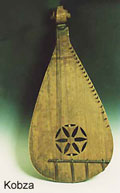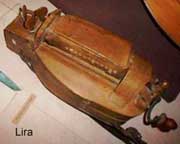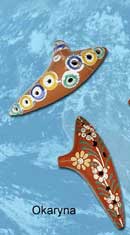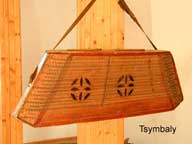|
Musical Instruments Bandura - Ukraine's
national instrument
bandura is a plucked instrument which is related to the medieval
psaltery and to the Russian husli types, though its form is entirely
different. The bandura is a chromatic, harp-like hybrid instrument with
forty or more melody strings and ten to thirteen unfretted bass strings on
the neck. It has an oval, flat body. The body is made out of a hollowed log,
which is rounded off. The table is oval or pear-shaped. The neck is
relatively short. Originally it used to be placed in the middle, but in more
recent times it was moved to the right. Generally handmade
instruments have no more than thirty strings, whereas the modern
mass-produced models can have up to sixty strings.
Experts cannot agree on the bandura's exact origin. The predecessor to the bandura was the kobza, a more simple but otherwise similar instrument, with less bass-and melody strings. A kind of lute still played nowadays in Ukraine and in Rumania/Moldavia also bears the name kobza, but most probably only the short neck and the name are derived from the old kobza. The part with the melody strings of the kobza/bandura could be interpreted as stemming from the old east-Slavonic husli. The kobzars (kobza players and singers) played an important role in the Ukrainian fight for freedom and the uprisings against the feudal lords. Bandurists existed from the 16th to the 19th century; they were generally blind and with the aid of their horses travelled throughout Ukraine as wandering minstrels, singing songs known as Dumy, which were songs based on heroic Cossack deeds and free spirit, which united the bandurists into a kind of brotherhood and musical guild. Bayan - button accordion with a keyboard. Bubon (tambourine) - a round tambourine (frame drum), with skin on one side mounted with five pairs of metal discs and a few small bells. The tambourine is beaten with a short and thick stick, played in the central and eastern regions of the Ukraine. Bukhalo - drum, somewhat similar, although smaller than a Turkish drum. Bukhalo z Tarilkoyiu - drum with cymbal, as played in the west of Ukraine. Harmoshka (accordion) Both the repertoire and the playing style of the Ukrainian accordion are deeply influenced by the Russian tradition. A small single-action instrument with 25 melody keys arranged in two rows. The bass side also has 25 keys, which produce a number of chords and fundamental bass notes. The small single-action accordions are called harmoshka just like the old double-action models. Husli – psaltery, a flat harp with a soundbody under the strings. Kuvitsi – panpipe Lira (hurdy-gurdy) The Ukrainian hurdy-gurdy works
exactly like the other European types: a wheel made to rotate by a crank
acts as a bow. The old examples are diatonic and provided with nine to
eleven keys. They have one melody string and two drone strings (tenor
and bayork). Chromatic hurdy-gurdies, which are furnished with two
rows of keys, were probably introduced after 1920. These instruments are not
held obliquely but laid horizontally on the lap. Their keys are provided
with a device (often a simple rubber band) to make them return to their
starting position.
Okaryna - pottery or clay
flute.
Tsymbaly - hammered dulcimer without legs. It is played while sitting, held on the lap, or standing upright with the tsymbaly in front of the stomach and held in position with the help of a belt around the neck of the player. .
Skrypka (fiddle) - violin. The fiddle tradition is dying out now, but there are indications that the level of playing used to be very high, with remarkably strong bowing. The tunes are played in the first position, but the compass is sometimes extended on the E string with a glissando by the 2nd or 3rd finger. Some fiddlers produce an archaic vibrato with these two fingers. Like the classical violin the skrypka is tuned in fifths and roughly in concert pitch, even when it is played solo. Sopilka (duct flute) - a wooden end-blown flute. Sopilkas of various length and tuning exist. The instrument usually is between 20 and 30 centimeters long and has 6 finger-holes. |

 Contrary to most European
hurdy-gurdy forms, the Ukrainian lira has never had a trompette (drone
string with rhythmical function). It is also noteworthy that quite a few
players turn the crank in both directions (first forwards and then backwards);
when the direction is changed, the sound is briefly interrupted. The
tradition of the lirnyky (hurdy-gurdy players) has played a
particular role in the Ukrainian musical culture of the 18th and 19th
centuries. All the musicians who are still active today belong to the
revival generation. Supposedly the instrument was imported from France by
the Ukrainian Cossacks of colonel Ivan Sirko, who took part in The Thirty
Years War (1618-1648).
Contrary to most European
hurdy-gurdy forms, the Ukrainian lira has never had a trompette (drone
string with rhythmical function). It is also noteworthy that quite a few
players turn the crank in both directions (first forwards and then backwards);
when the direction is changed, the sound is briefly interrupted. The
tradition of the lirnyky (hurdy-gurdy players) has played a
particular role in the Ukrainian musical culture of the 18th and 19th
centuries. All the musicians who are still active today belong to the
revival generation. Supposedly the instrument was imported from France by
the Ukrainian Cossacks of colonel Ivan Sirko, who took part in The Thirty
Years War (1618-1648).
